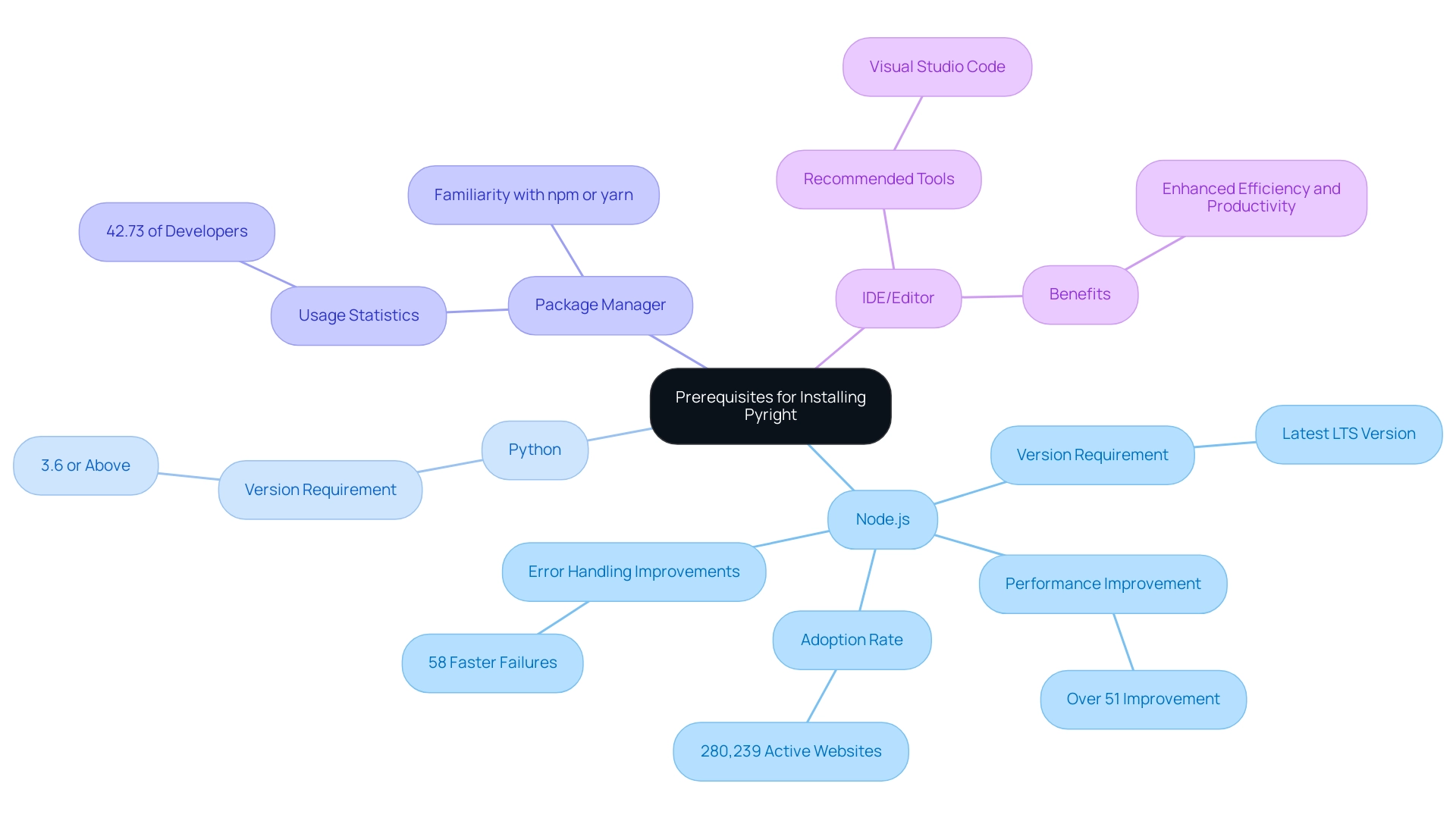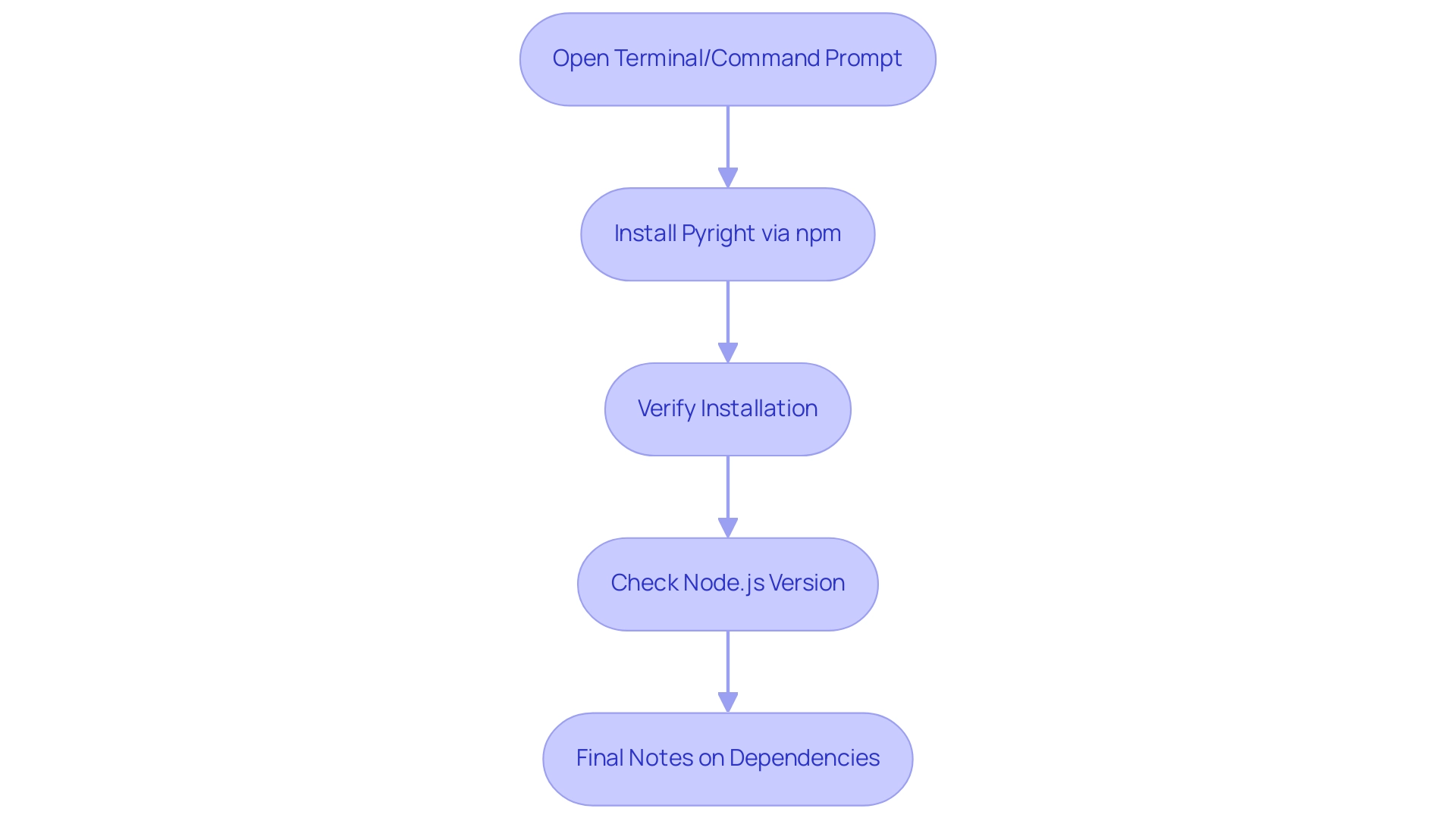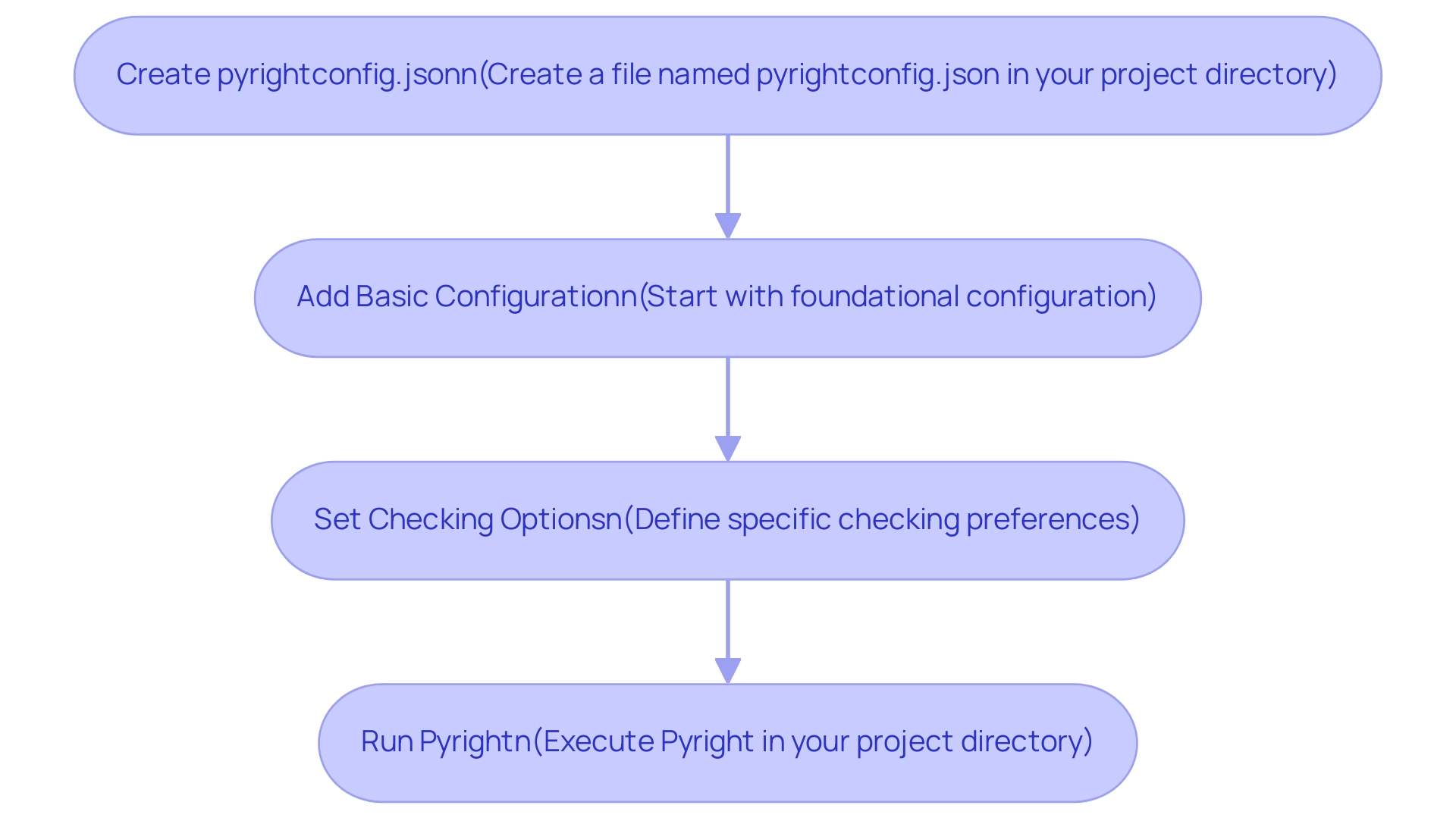Introduction
In the realm of modern software development, efficiency and precision are paramount. As projects grow in complexity, the ability to swiftly identify and rectify code issues becomes crucial. Enter Pyright—a powerful type checker that not only enhances productivity but also streamlines the development process.
By ensuring that essential prerequisites are in place and following a clear installation guide, developers can unlock the full potential of Pyright. From optimizing configurations to troubleshooting common hurdles, this article will guide readers through each step, empowering them to integrate Pyright seamlessly into their workflow and elevate their coding experience.
Prerequisites for Installing Pyright
Before continuing with the installation of the tool, it is crucial to verify that you have the following prerequisites in place to ensure a seamless setup:
- As Pyright functions as a TypeScript type checker on the JavaScript runtime environment, it is essential to download and install the latest Long Term Support (LTS) version from the official website. Significantly, this platform has demonstrated its ability to improve application performance by over 51%, establishing it as an essential element for contemporary programming. Furthermore, with approximately 280,239 active websites utilizing Node.js, its widespread adoption underscores its importance in the development landscape.
- Ensure that Python is installed on your system, with a preference for version 3.6 or above, and then you can install pyright to achieve optimal functionality. You can download the latest version of Python from the official Python website.
- Package Manager: Familiarity with a package manager such as npm (Node Package Manager) or yarn is beneficial to install pyright, as the tool is typically managed through these resources. With approximately 42.73% of professional developers utilizing different libraries and frameworks, mastering these package managers will enhance your workflow.
IDE or Editor: While not strictly necessary, having a code editor or Integrated Development Environment (IDE) like Visual Studio Code can significantly enhance your coding experience with this tool. The integration of these tools can improve your efficiency and productivity. Additionally, recent improvements in Node.js, such as enhanced error handling in the node: fs module, further validate the necessity of using Node.js for modern development practices.
Confirming these prerequisites will pave the way for a smooth installation process and ensure you can effectively install pyright to utilize the type checker.

Step-by-Step Installation Guide for Pyright
To install Pyright efficiently, follow these streamlined steps:
-
Open Terminal or Command Prompt: Launch your terminal (Linux/Mac) or command prompt (Windows) based on your operating system.
-
Install Pyright via npm: Execute the command below to install Pyright globally on your machine:
npm install -g pyright -
Verify Installation: After installation, confirm that Pyright is set up correctly by running:
pyright --versionYou should see the Pyright version number displayed in your terminal.
-
Check Node.js Version: Ensure compatibility by checking your Node.js version with the following command:
node -vThe output should reflect a version that is LTS (Long-Term Support) or higher.
Considering recent changes, such as the approval of PEP 668 in June 2022 and its execution in January 2023, using tools like a type checker can improve your Python programming experience and guarantee adherence to the latest standards. As Una states, "Basically it figures out all the co-dependencies for you at build-time so your Dockerfile can be as simple as RUN pip install my_app.whl." This emphasizes the efficiency that this tool brings to dependency management.
Additionally, while Rye is excellent for managing Python projects, it may not be ideal for short-term environments where quick setups are needed. Users can opt to use a 'Virtual Project' in Rye or continue using pyenv and virtualenv for simpler, temporary setups. By adhering to these steps, you'll be able to install pyright and have the tool primed for effective usage, contributing to enhanced productivity in your Python development tasks.

Configuring Pyright for Optimal Performance
To configure Pyright for optimal performance and rapid debugging capabilities, follow these straightforward steps:
-
Create a Pyright Configuration File: Begin by creating a file named
pyrightconfig.jsonin your project directory. This file is essential for customizing settings specific to your project, enabling automated debugging and code enhancement. -
Add Basic Configuration: Start with a foundational configuration that looks like this:
{ "include": ["src/**/*.report missing imports"], "exclude": ["**/node_modules/**"], "reportMissingImports": true }Modify the
includeandexcludepaths to fit your project structure, ensuring performance optimization. -
Set Checking Options: Define specific checking preferences that align with your project's requirements. For example:
{ "typeCheckingMode": "strict" }This setting ensures that strict type checking is enforced, enhancing code reliability and adherence to security best practices.
-
Run Pyright: Once you have configured the settings, execute Pyright in your project directory by running:
pyrightThis command will analyze your code according to the specifications outlined in
pyrightconfig.json, quickly identifying and fixing codebase issues. The tool offers detailed explanations and insights into what went wrong, helping you understand the issues and how they were resolved.
Properly configuring the tool not only boosts its performance but also allows you to tailor it to your unique development needs. Recent advancements demonstrate that with optimal settings, the type checking time can dramatically decrease, as evidenced by a reduction from 5080ms to just 6ms after implementing effective changes. Furthermore, a case study titled "Performance Comparison of Versions" shows that analysis time improved by 8% from version 1.1.281 to version 1.1.321, highlighting that performance differences are primarily driven by changes in the software itself.
This insight underscores the significant impact that configuration can have on performance, echoing maintainer Eric Traut's encouragement for users to explore further theories regarding performance discrepancies while maintaining compatibility with tools like esbuild-loader. Additionally, this tool enhances your code by fixing performance bottlenecks, finding security issues, adding exception handling, and improving code formatting in any part of your codebase in seconds.

Troubleshooting Common Installation Issues
If you encounter challenges during the installation of Pyright, consider these effective troubleshooting strategies:
-
Permission Issues: Should you face permission errors, executing the installation command with elevated privileges can often resolve the problem. For Linux or Mac users, run:
sudo npm install -g pyrightWindows users should open the Command Prompt as an administrator to perform the installation.
-
Node.js Validation: Ensure that the JavaScript runtime is installed and properly set up in your system’s PATH. You can do this by checking the version with:
node -vThis step ensures that your environment is set up for proper functionality.
-
Pyright Detection: If your terminal indicates that this tool is unrecognized, it’s essential to verify that the installation path for npm global packages is included in your system’s PATH. This oversight is a common hurdle that can easily be rectified.
-
Version Conflicts: Compatibility between your JavaScript runtime version and the latest Pyright release is crucial. If discrepancies arise, consider updating the JavaScript runtime from the official site to ensure alignment.
A significant percentage of developers, approximately 30%, report encountering permission issues during npm installations, highlighting the importance of addressing these common pitfalls. The growth of npm is notable; in 2011, there were less than 1000 packages available, which illustrates the increasing complexity of npm installations today. Furthermore, as Mathias Bus, a contributor to JavaScript and Node.js, mentions, "This is a good opportunity to send a shout out to Mathias Bus, who’s been a great contributor to JavaScript and Node.js, and a maintainer of many open source npm packages that assist daily developers."
Furthermore, cases like the Vagrant Path Length Issues on Windows illustrate how simple configuration tweaks can lead to successful installations. In that case, a custom Vagrant configuration was implemented to append \?\ to paths, allowing for longer directory names and resolving the issue. By applying these troubleshooting tips, you stand a much better chance of navigating common obstacles that may arise when you install Pyright and achieving a seamless setup.
Integrating Pyright with Your Development Environment
Incorporating the tool into your development environment can significantly enhance coding efficiency and increase safety of data types. Follow these essential steps for a seamless setup:
- For users of Visual Studio Code, begin by installing pyright from the Extensions Marketplace, as it is the type checker extension. This powerful integration provides real-time checking of data and error highlighting, ensuring you catch issues as you code. Significantly, the Pyright team highlights the importance of performance monitoring, stating, "I monitor checking performance closely for a number of repos... Are your code bases untyped or defined?" This insight emphasizes the commitment to maintaining high performance in checking.
- Other Editors: If you prefer editors like Sublime Text or Atom, be sure to install the relevant plugins that support external checker tools. Each plugin comes with specific documentation that outlines the necessary setup instructions.
- To begin the setup process, you need to install pyright. Setup in IDE: After you install pyright, make sure to adjust your IDE to assign the checker for types. This typically involves specifying the path to the executable or enabling it within your editor's settings menu.
- Testing the Integration: To verify that your integration is successful, create a sample Python file with deliberate errors in data types. Executing the tool should highlight these issues directly within your editor, confirming that the setup is functioning as intended.
By efficiently incorporating the tool, you position yourself to improve productivity and tackle errors early in the project cycle, ultimately resulting in smoother execution. Additionally, with holydragon's impressive 6,708 reputation points on the platform, it highlights the community's engagement and expertise in utilizing similar tools. Furthermore, understanding the role of the Python Packaging Authority (PyPA) in maintaining packaging standards can provide valuable context for the importance of type checkers like Pyright in the broader development ecosystem.
Conclusion
Embracing Pyright in the software development process can be a game changer for developers aiming to enhance their efficiency and precision. By ensuring that essential prerequisites are met—such as having the latest versions of Node.js and Python, alongside a solid understanding of package managers—developers can set the stage for a seamless installation experience. The straightforward step-by-step installation guide provided empowers users to get Pyright up and running with minimal hassle, allowing them to focus on what truly matters: writing high-quality code.
Configuring Pyright for optimal performance is another critical aspect highlighted throughout the article. By creating a tailored pyrightconfig.json file, developers can significantly boost their type checking capabilities and streamline debugging processes. The potential for performance improvements, as demonstrated by case studies and empirical data, reinforces the importance of proper configuration in achieving the best results.
Furthermore, the troubleshooting section equips readers with practical strategies to navigate common installation challenges, ensuring that obstacles do not hinder productivity. Integrating Pyright into popular development environments like Visual Studio Code not only enhances coding efficiency but also fosters a proactive approach to error detection and code quality.
In conclusion, by leveraging Pyright’s powerful features and following the outlined steps, developers can transform their coding experience, leading to improved productivity and a more robust codebase. The integration of type checking into the development workflow is not just a technical enhancement; it represents a commitment to excellence in software development that can ultimately lead to greater project success.
Frequently Asked Questions
What are the prerequisites for installing Pyright?
The prerequisites for installing Pyright include having the latest Long Term Support (LTS) version of Node.js, Python version 3.6 or above, familiarity with a package manager like npm or yarn, and ideally, a code editor or Integrated Development Environment (IDE) such as Visual Studio Code.
Why is it important to install the latest LTS version of Node.js?
Installing the latest LTS version of Node.js is crucial because it has been shown to improve application performance by over 51%. Additionally, Node.js is widely adopted, with approximately 280,239 active websites using it, making it essential for modern development.
How can I check if Python is installed on my system?
You can check if Python is installed on your system by running the command python --version in your terminal or command prompt. It is recommended to have Python version 3.6 or above for optimal functionality with Pyright.
What package managers can I use to install Pyright?
You can use npm (Node Package Manager) or yarn to install Pyright, as the tool is typically managed through these package managers.
Is having an IDE necessary for using Pyright?
While having an IDE or code editor like Visual Studio Code is not strictly necessary, it can significantly enhance your coding experience and improve your efficiency and productivity when using Pyright.
What are the steps to install Pyright?
To install Pyright, follow these steps: 1. Open Terminal or Command Prompt. 2. Run the command npm install -g pyright to install Pyright globally. 3. Verify the installation by running pyright --version to see the version number. 4. Check your Node.js version with node -v to ensure it is LTS or higher.
How does using Pyright improve Python programming?
Pyright helps improve Python programming by acting as a type checker, which can enhance the programming experience and ensure adherence to the latest standards. It efficiently manages dependencies, simplifying the build process.
What alternatives are there for managing Python projects besides Pyright?
Alternatives for managing Python projects include using Rye, which is excellent for managing projects, or continuing to use pyenv and virtualenv for simpler, temporary setups.




